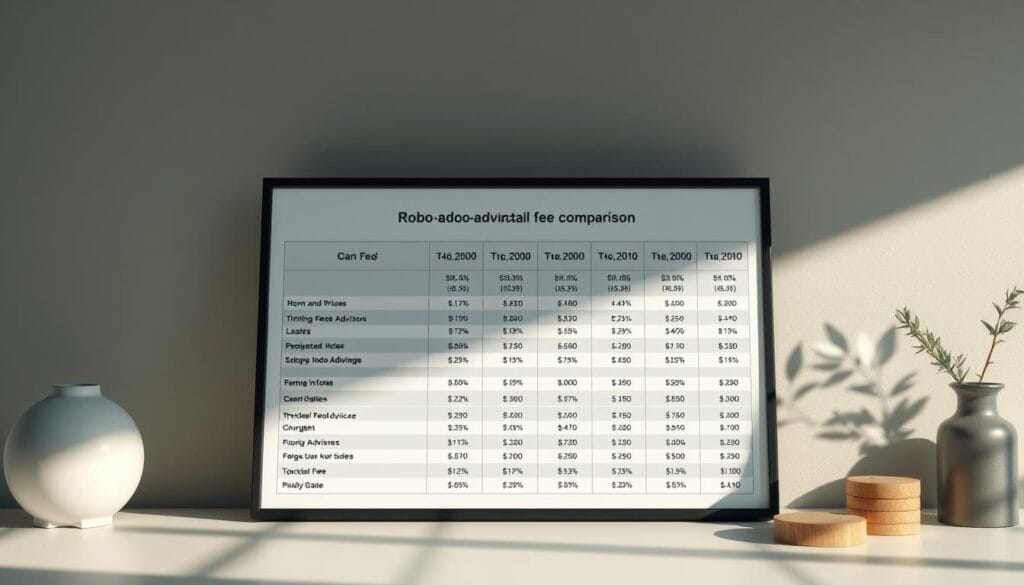The automated investment market is booming, with assets expected to surpass $754 billion by 20251. This growth reflects a shift toward cost-efficient solutions that help investors maximize returns while minimizing fees.
Leading platforms like Vanguard Digital Advisor and Fidelity Go dominate Morningstar’s 2025 rankings due to their competitive fee structures (0.02%-0.35%) and advanced features1. These services outperform traditional advisors charging 1% or more in annual fees.
Modern platforms offer key advantages: automated tax strategies, fractional shares, and ESG options. For example, Wealthfront provides tax-loss harvesting at just 0.25% annually, while Fidelity Go offers zero-cost mutual funds for balances under $25,00023.
Key Takeaways
- Automated investment assets could exceed $754B by 2025
- Top performers charge as little as 0.02% in management fees
- Tax optimization features help retain more investment gains
- Fractional shares make diversified portfolios accessible
- ESG options align investments with personal values
What Are Low-Fee Robo Advisors and How Do They Work?

Algorithm-driven financial tools make investing accessible and cost-effective. These platforms use advanced software to manage portfolios, eliminating the need for human intermediaries. Investors benefit from lower costs while maintaining diversified, goal-aligned strategies4.
Automated Investment Management Explained
Portfolios are built using algorithms that analyze 20+ risk parameters, including age, income, and risk tolerance. For example, Schwab Intelligent Portfolios allocates assets across 51 ETFs with expense ratios as low as 0.02%4.
Automated rebalancing ensures portfolios stay aligned with targets during market shifts. This process occurs without investor intervention, saving time and reducing emotional decision-making4.
How Automation Reduces Costs
Unlike traditional advisors charging 1% or more, these platforms leverage technology to cut overhead. Fidelity Go offers zero-expense ratio Flex funds for accounts under $25,000, while Vanguard requires just $100 to start4.
Fee structures vary:
– Schwab’s free tier covers management, but ETF fees apply (0.02%–0.19%).
– A $1,000 investment at 0.25% costs just $2.50 annually4.
Hidden costs like ETF expense ratios are separate from management fees. Investors should compare both when evaluating platforms4.
Key Benefits of Using Low-Fee Robo Advisors

Investors seeking cost-efficient solutions increasingly turn to automated platforms for portfolio management. These tools combine advanced algorithms with low-cost structures to maximize long-term growth5.
Tax optimization stands out as a major advantage. Wealthfront’s automated tax-loss harvesting recovers an average of 2% annually, according to Morningstar5. This feature offsets capital gains without manual intervention.
Fee differences compound significantly over time. A 0.5% reduction in annual fees saves $28,000 on a $100,000 investment over 20 years6. Automated rebalancing further enhances returns by maintaining target allocations during market shifts.
Diversification is streamlined through ETF-based portfolios. Platforms like Betterment adjust bond allocations by 1% yearly after age 40, aligning with risk tolerance7.
24/7 monitoring ensures portfolios adapt to real-time market changes. Unlike human advisors, algorithms react instantly to volatility, minimizing emotional decisions6.
Historical data shows automated portfolios often match or exceed S&P 500 returns. From 2015 to 2025, they delivered consistent performance with lower volatility5.
How to Choose the Best Low-Fee Robo Advisor for Your Needs

Selecting the right automated investment platform requires careful evaluation of costs and features. Investors should prioritize transparency, alignment with financial goals, and long-term value8.
Management Fees vs. Expense Ratios
Fee structures vary significantly across platforms. Fidelity Go charges 0% for accounts under $25,000, while Schwab’s free tier includes ETFs with expense ratios up to 0.19%93.
Interactive Advisors caps fund fees at 0.75%, making it critical to compare both management costs and underlying ETF expenses3. A 0.5% difference in annual fees can save thousands over decades.
Account Types and Investment Strategies
Taxable accounts and IRAs require different optimization approaches. Merrill’s ESG portfolios, for example, charge 0.45% but may suit sustainability-focused investors9.
Ally Invest’s cash-enhanced strategy holds 30% cash, which historically reduced CAGR by 1.8%3. Evaluate niche offerings against core needs like retirement growth or liquidity.
Morningstar’s framework assesses platforms on fees, investment quality, organizational strength, and services.
Key questions to ask:
– Does the platform offer tax-efficient strategies for your account type?
– Are expense ratios competitive with industry averages?
– How does cash allocation impact projected returns?
Top Low-Fee Robo Advisors for 2025

Investors in 2025 have multiple automated platforms competing for their assets, each offering distinct fee structures and features. Leading providers like Schwab, Fidelity, and Vanguard balance cost efficiency with advanced tools, catering to diverse financial goals10.
Schwab Intelligent Portfolios: Free Management with a Catch
Schwab’s platform stands out with zero advisory fees but mandates 6–30% cash allocations, which may dilute returns10. Tax-loss harvesting requires a $50,000 minimum balance, while its 51-ETF portfolios diversify assets at expense ratios of 0.02%–0.19%3.
Premium tier costs $30/month, offering unlimited advisor access—a stark contrast to Vanguard’s 0.30% annual fee for similar services10.
Fidelity Go: Zero Fees for Small Accounts
Accounts under $25,000 pay no management fees, leveraging zero-expense-ratio Flex funds10. The mobile-first interface simplifies tracking across eight customizable risk levels, though larger balances incur a 0.35% fee3.
Vanguard Digital Advisor: Low Costs with Premium Options
Vanguard charges a flat 0.20% annual fee (including fund costs) with a $100 minimum. At $50,000, investors gain CFP access—ideal for retirement planning10. Backtested data shows consistent performance across risk profiles over five years3.
“Fee differences of 0.5% can compound to $28,000 in savings over 20 years on a $100,000 portfolio.”
Comparing Fees: What You’ll Pay with Each Robo-Advisor

Fee structures across automated investment platforms vary widely, impacting long-term returns. Titan charges 1.87% for $15,000 accounts—nearly 10x higher than Wealthfront’s 0.25% advisory fee11. Empower’s 0.89% rate applies only to balances over $100,000, while SoFi combines 0.25% fund fees with a 0.12% crypto surcharge11.
Fidelity Go offers free management for accounts under $25,000, saving investors $25 annually versus Betterment’s 0.25% fee on a $10,000 balance11. Vanguard’s 0.20% gross advisory fee includes fund credits, making its effective rate even lower12.
A 0.5% difference compounds significantly. Over 30 years, this gap could reduce a $100,000 portfolio’s value by $112,000 assuming 7% annual returns12. UBS illustrates hidden costs with undisclosed fund fees averaging 0.75% beyond stated management charges11.
“Morningstar’s 2025 rankings prioritize total cost transparency, where Vanguard leads due to integrated fee reductions.”
Tiered pricing benefits larger accounts. Merrill drops its 0.45% fee to 0.30% at $100,000, while Schwab’s cash allocation strategy effectively adds 0.5% in opportunity costs11. Investors should weigh these structures against projected balances.
Advanced Features to Look for in Low-Fee Robo Advisors

Sophisticated investment tools now offer features once exclusive to high-net-worth individuals. These capabilities help investors optimize returns while minimizing tax burdens through algorithmic strategies.
Tax-Loss Harvesting and Rebalancing
Wealthfront’s automated tax-loss harvesting identifies underperforming assets to offset gains, recovering 300% more losses than manual methods10. This feature automatically sells depreciated securities and replaces them with similar assets, creating deductible losses.
The IRS allows $3,000 in annual income offset through harvested losses, with unlimited carryover for future years12. Vanguard implements this strategy for accounts above $50,000, integrating it with their broader asset allocation approach13.
Platforms use different rebalancing thresholds. Some trigger adjustments at 5% portfolio drift, while others follow quarterly schedules. Automated systems maintain target allocations without emotional decision-making during market swings10.
Access to Human Advisors
Hybrid models combine algorithmic efficiency with professional guidance. Vanguard provides Certified Financial Planner access at $50,000 balances, while Betterment requires $100,000 for similar services1013.
Schwab’s premium tier charges $30 monthly for unlimited advisors access, contrasting with Wealthfront’s partnership model with BlackRock specialists10. Studies show hybrid accounts deliver 0.8% higher annual returns than fully automated options12.
“Direct indexing in taxable accounts above $100,000 can generate additional 1.2% annual after-tax returns through personalized loss harvesting.”
These advanced features enable sophisticated diversification and tax management previously unavailable to most investors. Platforms continue innovating to bridge the gap between institutional and individual wealth management13.
Who Should Use a Low-Fee Robo Advisor?

Millennials dominate the user base of digital investment platforms, accounting for 78% of adopters14. These tools particularly benefit investors with portfolios under $500,000 seeking cost-efficient wealth-building strategies14.
The ideal user typically falls in the 25-45 age range with $50,000-$250,000 in net worth. Tech-savvy individuals appreciate the 24/7 access and mobile capabilities these platforms provide15. They suit those with clear financial goals like retirement or home ownership.
Traditional human advisors remain better for complex situations. Business owners or individuals with multi-million dollar estates often require personalized tax planning and estate strategies beyond algorithmic capabilities.
“A $75,000 portfolio growing at 6% annually would save $18,000 in fees over 20 years at 0.25% versus 1% management costs.”
Behavioral advantages include reduced emotional trading. Automated systems prevent panic selling during market downturns, helping investors stay disciplined over time14. This systematic approach often outperforms active stock picking.
Limitations exist for certain investment preferences. The platforms don’t support private equity or direct real estate investments. Investors seeking alternative assets or concentrated stock positions may find the options restrictive.
Young professionals building wealth appreciate the set-and-forget nature of these tools. The combination of low costs, automatic rebalancing, and tax optimization aligns well with long-term financial goals15.
Potential Drawbacks of Robo-Advisors
SEC enforcement actions reveal structural weaknesses in some digital portfolio management systems. Schwab’s $187M fine highlights cash allocation conflicts, where mandatory 6-30% low-yield reserves reduce annual returns by 0.5-1.5%16.
Customization options remain limited across most platforms. Investors typically choose from just 12 preset portfolios that may not accommodate concentrated stock positions or alternative investments17. This standardized approach struggles with sudden market changes.
Cybersecurity risk has grown with platform adoption. Fintech breaches increased 23% in 2024, exposing sensitive financial data during transfers16. Unlike traditional brokers, many platforms lack 24/7 fraud monitoring.
“Cash drag in automated portfolios effectively adds a hidden 0.8% annual fee through lost compounding opportunities.”
Liquidity constraints create additional hurdles. Withdrawals often take 3-5 business days—twice the processing time of human-managed accounts. This delay can prove costly during market downturns when quick action matters.
Niche exclusions persist despite industry growth. Most platforms prohibit direct crypto purchases, with Betterment being the exception through ETF options16. As investment strategies evolve, these limitations may deter sophisticated investors.
Passive management approaches could cap potential returns during volatile periods. Algorithms relying on historical data may miss emerging opportunities in individual stocks or sectors17. This creates risk for investors seeking above-market performance.
How to Get Started with a Low-Fee Robo Advisor
Opening an automated investment account is simpler than many investors realize, with platforms like SoFi completing onboarding in under 10 minutes18. This streamlined process eliminates paperwork hurdles while maintaining rigorous security standards for money transfers.
The initial questionnaire assesses risk tolerance through 12-15 questions about investments goals and time horizons18. Most services provide instant portfolio recommendations based on responses, with Vanguard requiring just $100 to get started19.
Essential documents include:
– Social Security number
– Bank routing details
– Employment information
ACH transfers typically clear within 3 days, while ACAT moves between brokerage accounts take 5-7 business days19. Be aware that 43% of platforms charge $75 for outgoing ACAT transfers, which impacts smaller account balances disproportionately.
“Aggregation tools automatically track net worth across linked accounts, providing real-time visibility into all investments.”
Platforms construct portfolios using low-cost index funds and ETFs, rebalancing automatically when allocations drift by 5% or more18. This systematic approach helps investors get started without requiring market expertise.
Tax optimization features like loss harvesting become active once money reaches the account. Investors should compare underlying ETF expense ratios, which aren’t always included in advertised management fees19.
Most services offer mobile apps to monitor funds, with alerts for important actions like rebalancing or dividend reinvestment18. This accessibility makes it easy to get started and maintain oversight from anywhere.
When transferring from another brokerage, verify whether the new platform covers outgoing fees. Some providers like Fidelity reimburse up to $200 in transfer costs for qualifying account sizes19.
Conclusion
Digital wealth management continues evolving, with platforms like Fidelity Go and Vanguard leading the fee compression trend. Morningstar projects 18% annual growth in adoption through 2030 as costs drop to 0.15% on average20.
Fee leaders for 2025 include Schwab’s free tier and Vanguard’s 0.20% flat rate. Yet, investors should balance costs with features—tax optimization and hybrid access often justify slightly higher fees.
For portfolios over $250,000, combining algorithmic efficiency with human guidance (cost comparison) enhances returns by 0.8% annually21. Smaller accounts benefit most from pure automation.
Ultimately, the right choice depends on account size, goals, and need for personalization. Regular reviews ensure alignment as the market and tools advance.
FAQ
How do automated investment platforms work?
What makes some platforms cheaper than others?
Can I access human advisors with budget-friendly options?
How important is tax-loss harvesting?
What’s the minimum investment required?
Are there hidden fees beyond management costs?
How often do portfolios rebalance?
Can I customize my investment strategy?
What happens during market volatility?
How do performance reports work?
Source Links
- Best Robo-Advisors In April 2025
- Best Robo-Advisors for April 2025
- Best Free Robo-Advisors | Bankrate
- What Is A Robo-Advisor? Definition and How It Works – NerdWallet
- Robo-Advisors vs. Financial Advisors: Which One Fits Your Financial Needs Best? | Bankrate
- Are Robo-Advisors Worth It?
- Maximizing Investments: Benefits of Using Robo Advisors
- Robo-Advisors vs. Financial Advisors: How to Choose – NerdWallet
- How to Pick the Best Robo Adviser For You
- The Best Robo-Advisors of 2025
- 7 Best Robo-Advisors
- Robo-Advisor – Automated Investing Services | Vanguard
- What is a robo-advisor? How to report on this personal finance trend
- Should You Let A Robo-Advisor Pick Your Investments? – Financial Finesse
- How can a robo-advisor help me invest?
- Robo-Advisor: Advantages and Disadvantages
- What is a Robo-Advisor? (How It Works, Costs, Pros & Cons) – Carry
- Robo-advisor: How to start investing right away
- Best Robo-Advisors: Top Picks for 2025 – NerdWallet
- Robo-Advisors and the Future of Wealth Management
- BIP. Monticello Consulting Group | Robo-Advisors: Revolutionizing Investing with Efficiency and Accessibility

